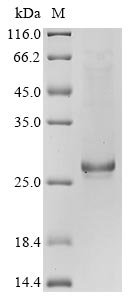This Recombinant Bovine coronavirus Protein I (N) is expressed in E. coli and includes the full-length sequence from amino acids 1 to 207. The protein carries a C-terminal 6xHis-tag, which helps with purification and detection. SDS-PAGE analysis shows the protein reaches a purity level greater than 85%, making it suitable for various research applications. This product is for research use only—not for diagnostic or therapeutic purposes.
Protein I (N) of Bovine coronavirus (BCoV) appears to play a central role in the viral life cycle. The protein is primarily involved in viral replication and assembly processes. As the nucleocapsid protein, it's essential for packaging the viral RNA genome and likely contributes to maintaining the virus's structural integrity. Studying this protein may be crucial for understanding coronavirus biology and could help in developing antiviral strategies.
Potential Applications
Note: The applications listed below are based on what we know about this protein's biological functions, published research, and experience from experts in the field. However, we haven't fully tested all of these applications ourselves yet. We'd recommend running some preliminary tests first to make sure they work for your specific research goals.
The protein is expressed in E. coli, a prokaryotic system that lacks eukaryotic post-translational modifications and often fails to produce correctly folded viral nucleocapsid proteins, which typically require specific disulfide bond formation and proper tertiary structure for RNA-binding activity. While the C-terminal 6xHis tag may improve solubility, there is no evidence of proper folding (e.g., via circular dichroism spectroscopy or thermal shift assays) or bioactivity validation (e.g., RNA-binding assays). The protein may be partially or completely misfolded, significantly limiting its ability to mimic native nucleocapsid protein function.
1. Antibody Development and Validation
This recombinant nucleocapsid protein can serve as an immunogen for antibody production, but resulting antibodies must be validated against native BCoV nucleocapsid protein - E. coli-expressed protein may present non-native epitopes, potentially generating antibodies with poor recognition of the properly folded viral protein in infected cells. While the His tag facilitates purification, antibody specificity should be confirmed using natively folded protein standards.
2. Protein-Protein Interaction Studies
Pull-down assays using the His tag can identify potential binding partners, but results are highly dependent on correct protein folding - misfolded nucleocapsid protein may yield non-specific interactions or miss genuine binding partners. Any identified interactors require validation through co-immunoprecipitation experiments with native protein from infected cells to confirm biological relevance.
3. ELISA-Based Detection Assays
This protein can be used in research ELISA formats, but quantitative accuracy depends on proper folding - misfolding may affect antigen-antibody recognition patterns. While suitable for initial assay development, results should be verified using native protein standards, particularly for quantitative measurements of antibody responses or viral protein levels.
4. Structural and Biochemical Characterization
The protein is suitable for preliminary biophysical analysis (circular dichroism, dynamic light scattering, etc.), but results may not reflect native protein properties. These studies can assess basic stability parameters but cannot validate native conformation without comparison to properly folded reference standards. The His tag may also influence oligomerization studies and should be considered when interpreting results.
Final Recommendation & Action Plan
This E. coli-expressed BCoV nucleocapsid protein requires rigorous validation before reliable biological applications. First, confirm structural integrity through circular dichroism spectroscopy and thermal shift assays to assess folding quality. Second, validate functionality using RNA-binding assays or comparison with an eukaryotic-expressed protein. For antibody development, test resulting antibodies against native nucleocapsid protein; for interaction studies, confirm findings with orthogonal methods. If the protein shows evidence of misfolding, consider alternative expression systems (baculovirus, mammalian cells) or include refolding procedures. Always include appropriate controls using natively folded protein when possible to ensure biological relevance of findings.






